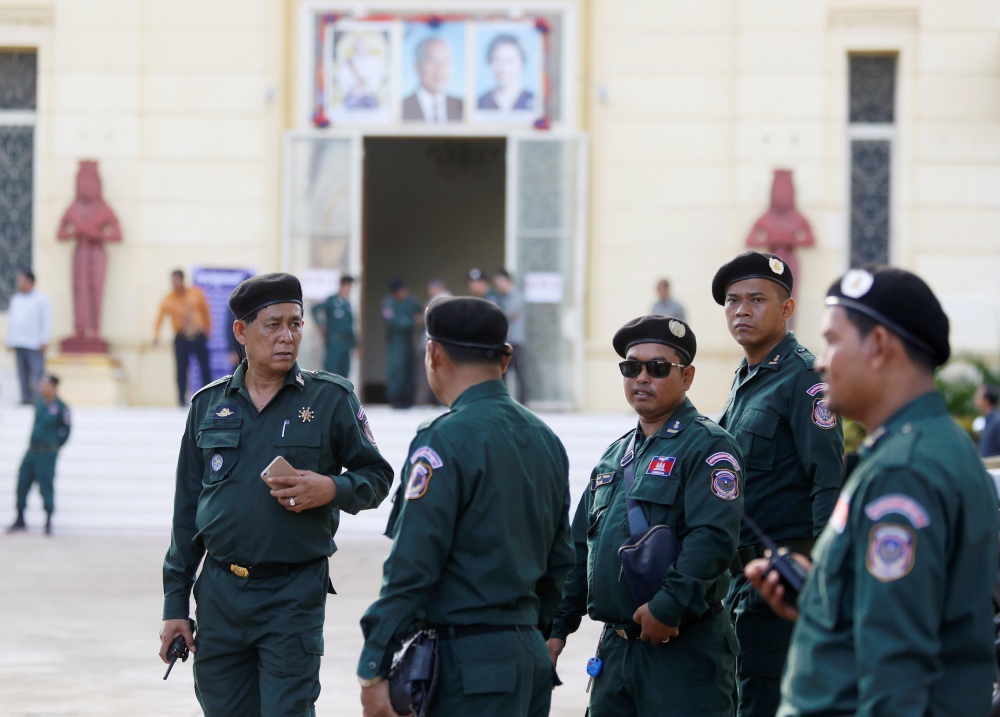Phnom Penh
Thomson Reuters Foundation
US and Australian crime fighters are preparing Cambodia for a spike in online child sex abuse cases but local officials fear that predators are a step ahead of police due to narrow laws.
The spread of cheap, high-speed internet and the rise in mobile phone ownership is fuelling cybersex trafficking across South-East Asia – a form of modern-day slavery where children are abused and raped over livestreams for paying clients worldwide.

Police officers stand guard at the Supreme Court in Phnom Penh, Cambodia, on 16th November, 2017. PICTURE: Reuters/Samrang Pring
Agents from the US Federal Bureau of Investigation and Australian Federal Police have in recent months started training Cambodian police to investigate the crime amid concerns that it is becoming more prevalent in the country.
Yet undercover investigations in sexual abuse cases are not permitted under Cambodian law, hindering the authorities’ ability to tackle the trend, said Khuon Sokpiseth, deputy director of the interior ministry’s cybercrime department.
“We need this capacity to infiltrate networks and we need new cybercrime laws for the department to properly carry out its mission,” Sokpiseth told the Thomson Reuters Foundation.
A more comprehensive cybercrime law has been in the pipeline for at least two years, he said, without giving further details.
The interior ministry and the justice ministry both declined to discuss the proposed legislation.
The Philippines is considered to be the epicentre of cybersex trafficking – with its high level of English, rampant poverty and cheap Internet access – yet campaigners say the crime is spreading across the region from Vietnam to Cambodia.
At least three-quarters of Cambodians had internet access as of the start of this year, up from 45 per cent of the population in 2017, according to We Are Social, a social media marketing firm.
“Countering the online sexual exploitation of children is a priority…for Cambodia,” said a spokesman for the AFP, which ran a workshop with local law enforcement agencies in July.
“Of particular concern is the rise in instances and rates of child exploitation overseas with Australians involved.”
The United States, Britain and Australia are the main consumers of child sex abuse streamed over webcam, he added.
The FBI confirmed it had been involved in a recent workshop on the issue with Cambodian police, but did not comment further.
In the Philippines, the AFP is part of a joint taskforce launched earlier this year to tackle online child sex abuse alongside Britain’s National Crime Agency, local police and the International Justice Mission, an anti-trafficking charity.
The head of the taskforce, police general William Macavinta, told the Thomson Reuters Foundation that more than 90 per cent of successful investigations relied on undercover investigations.
In Cambodia, charity Action Pour Le Enfants, which works with local police and the FBI, is also calling for a new cybercrime law to be adopted to prevent the crime from growing.
The government last month said the number of trafficking victims rescued in Cambodia had more than doubled in the first half of the year, compared to 2018, with 101 children freed.
Yet the head of APLE, Samleang Seila, said child trafficking had moved off the streets and into “underground environments” in recent years, and that there were now thousands of reports of illicit imagery of children being shared online each month.
Investigators in Cambodia must be allowed to go undercover “to infiltrate networks and dig out criminals”, Seila added.
“If we are only relying on victim complaints and reports from the community, I think we will forever be running behind.”
More than 260,000 of Cambodia’s 16 million people are estimated to be trapped in slavery, according to the Global Slavery Index by the Australia-based Walk Free Foundation.





